"I'm not into watches, but —" are the famous last words of everyone who goes down the rabbit hole of personal horology. In my case, ignorance was bliss until a few months ago, when my partner went shopping to find a watch with some fitness functions.
My partner, Drea, has ADHD. We've learned since her diagnosis that alarms and reminders help keep her focused, and that the modern multi-tool we anachronistically call a phone can be both a helpmeet and a hindrance. How many hours have we spent — whether we are neurotypical or not — hunting down tracker and timer apps on the phone, and how many hours have we spent configuring those apps?
Drea wanted to record the time she spent on rehabilitating her fingers from a climbing injury. She also wanted to set a limit to her climbing sessions, to prevent overuse injuries. A phone wouldn't cut it. She wanted to be able to do something while not perenially tethered to the damn thing; it was already the first thing she woke up to and the last thing she saw before sleeping.
Resonance as reason
The show began when we went shopping. I'd not thought of watches in decades, having spent a childhood taking off and on again those itchy bands and destroying all the nice watches my mother gave me — a Timex Ironman and a Swatch, which was maybe too much responsibility for a second grader.
Drea and I went to the department store. Casio delivered on the nostalgia, but I wasn't really seeing. At first, I didn't think too much of any model I looked at. We went to a couple more stores, again with no watch drawing an emotional or utilitarian response out of either of us.
Then we went to the dedicated G-Shock store.
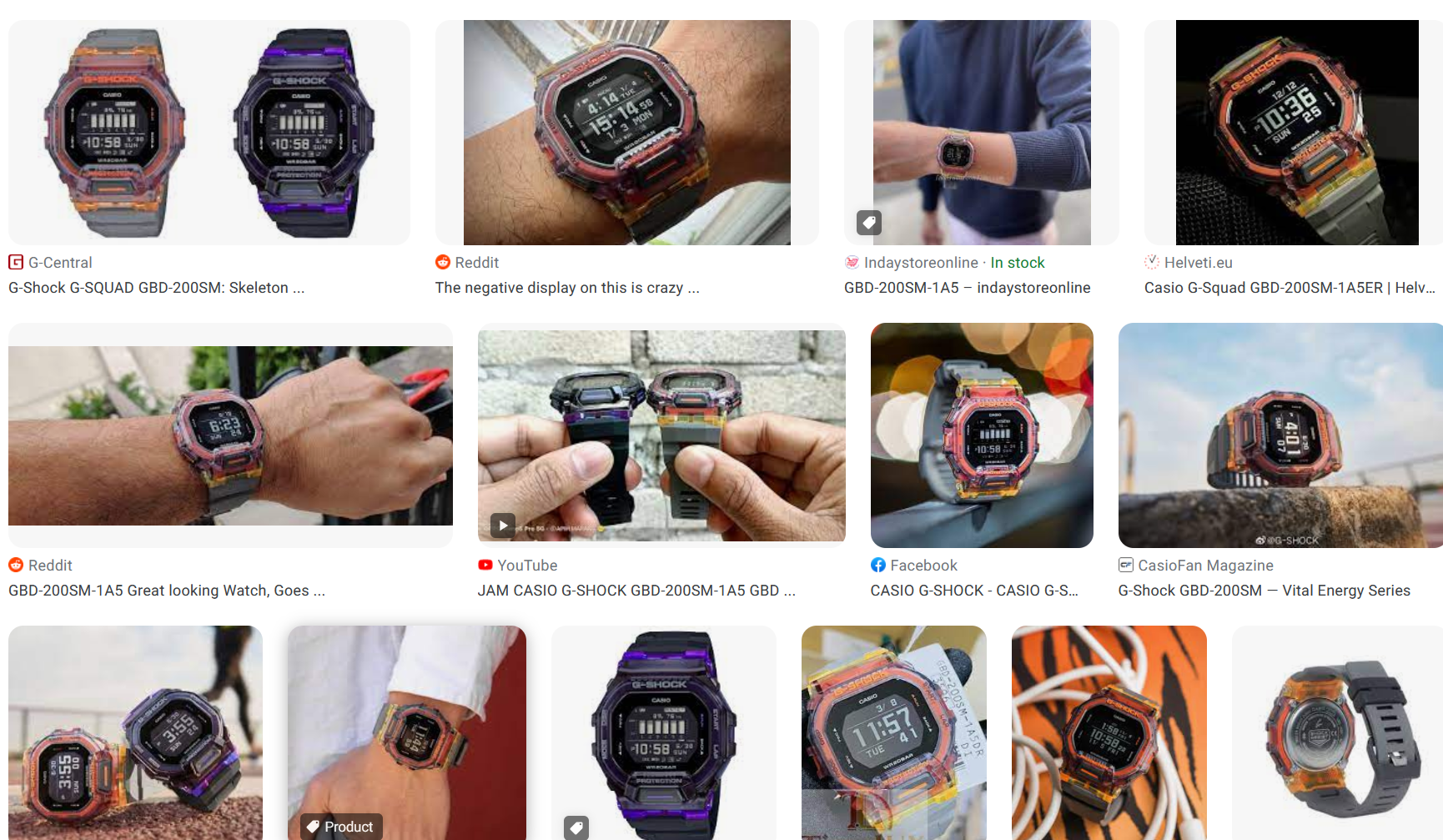
I saw, for the first time, a bright orange and grey G-Shock. It was a smartwatch, so it had "everything". It was also dismayingly huge, too big for my wrist. But I felt something for this watch. I wear primarily black from head to toe, so a bit of color would absolutely pop. It would telegraph, to strangers, that I was only ninety percent still in my goth art school phase. (I am in my thirties and I do technical writing for a living.) We looked around a bit more. There were new G-Shocks that didn't look like the ones from my childhood; these G-Shocks were not square nor Baby-G round: they were octagons.
I picked out something the sign called a "Tri-Color" octagonal G-Shock. The border was white, the lines to indicate hours were red and the hands were in blue. Technically the watch background was a fourth color — black — as was the strap, but I understood the "Tri-Color" marketing theme was referring to the prep-school accent colors (and my need to point this out is why I'm a technical writer, not a content writer). No, I didn't know any watch-related terms at the time. I only knew that this watch passed my personal standards: it had a mecha feel to it. It worked with the material and the geometric design of the watch. It wasn't trying to be anything except what it was.
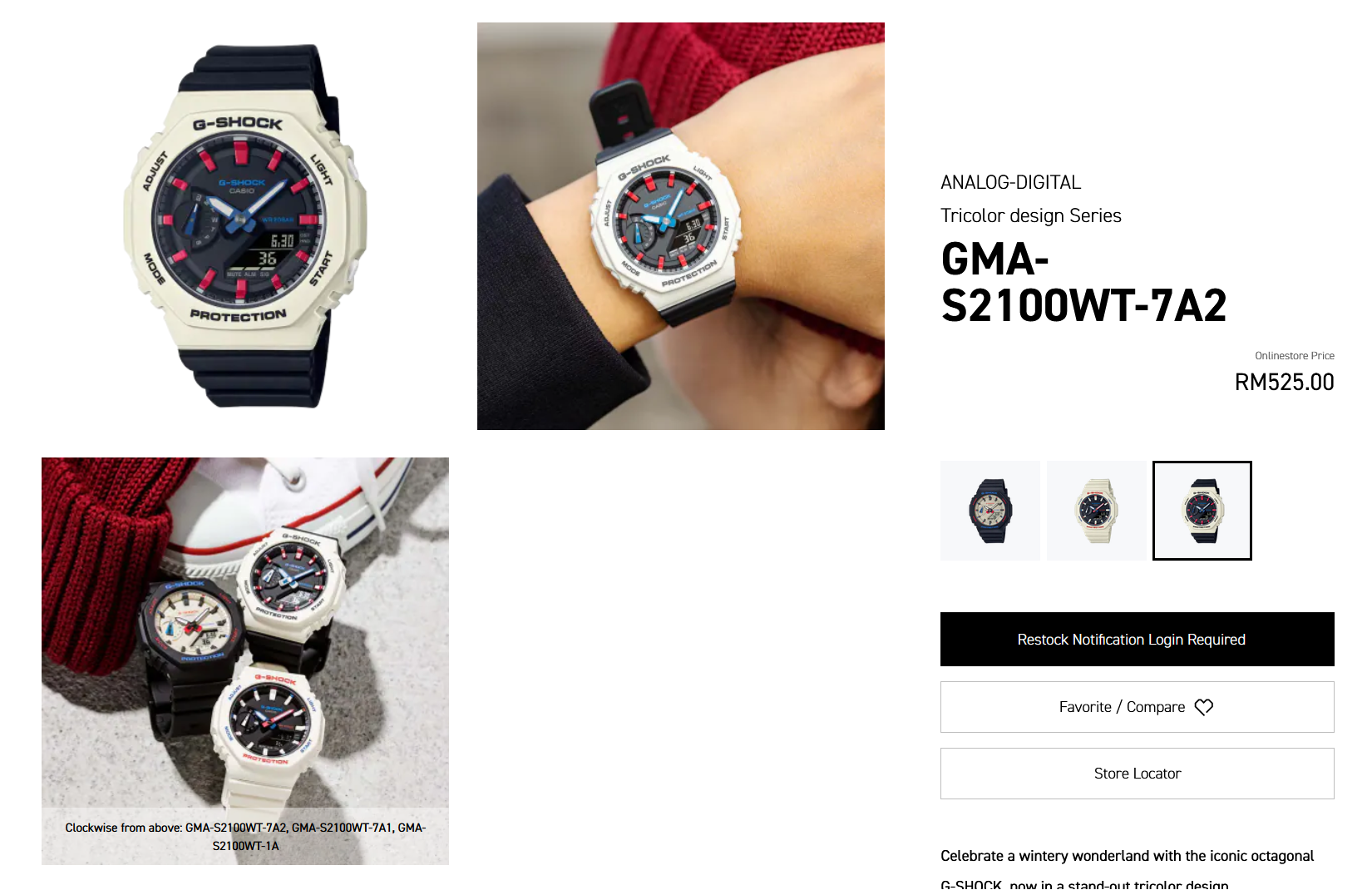
I offered it to my partner. These models were smaller than the usual sized G-Shock octagons, but they were still too big for my partner's wrist. She ended up with the tiniest Timex Expedition, which served her purposes. For that day, it was me with the emotional pull and her with the utilitarian one.
Not even three days later I came back to snap it up for myself after learning basic watch terms. It was a "CasiOak", so-called because it looked like some other more expensive brand. If I was being honest, I bought it for its white and red, which bore a reaching, barely-passing resemblance to Mass Production Eva Units. For Gundam fans, the red, white, and blue add up to almost match a number of lead Gundam models, such as the Strike and Exia, though it lacks the yellow highlights on the Gundam.

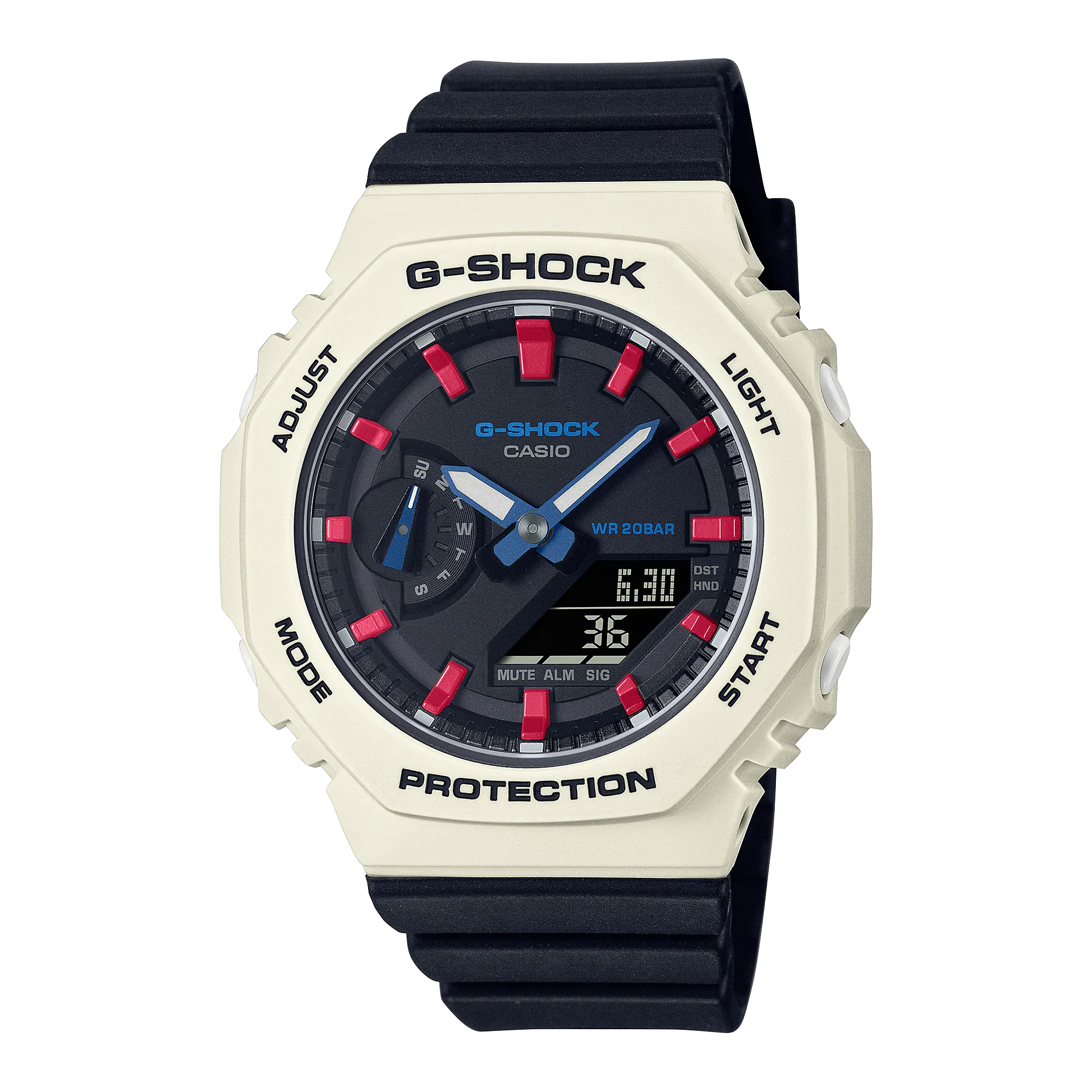
Justified by utility
While I never got into the habit of using the timer on my phone — you always have to pull it out of a pocket — I got into the habit of using the timer on my watch within the week I'd bought it. I'd never owned a watch with an ana-digi (analog-digital) display so discovering this bit of UI/UX was a revelation. I could read the time and run a timer on the same 'screen'! Watches can still be useful! I didn't just buy it because of an arbitrary color scheme preference!
(I may have felt a little like I needed to justify the purchase. It did the job beautifully.)
I set the timer to twenty minutes. This duration fits many activities in my life. It follows the 20/20/20 rule: twenty minutes on the screen, twenty seconds look-away time at some object, at least twenty feet away. It's enough time to do a quick sweep, dishwashing, and general puttering-around. It's enough time to take a break.
Anyway, that's the first story arc for this bit of consumerist character development. I got hooked on the watch. Not on watches, per se. I fell very briefly into the rabbit hole, and would fall again for the second arc of the story.
Fidget toys for adults
The second arc began when I started to look for other watches with alarms or timers. At that point I was probably more invested than the person who most needed it. My partner already considered herself well stocked with reminder apps, timer apps, and a sturdy physical watch that could take a beating on plastic rock holds at the gym.
I discovered diver's watches and realized that the border of the watch — the bezel —actually rotated, functioning as a visual timer. A visual timer! But the bezels were not always useful for day-to-day tasks, sporting different markers for different reasons. The most basic, a diver's watch, typically counted up, not down. After hours looking at regatta watches, watches with GMT bezels, and other fun rotating bezels, I gave up.
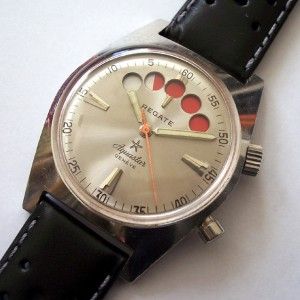
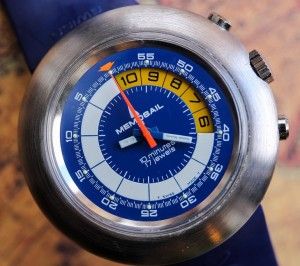
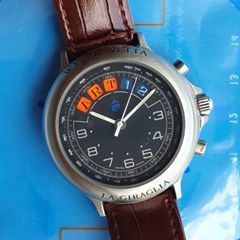
Then I stumbled on the Timex Turn-N-Pull Easy-Set Alarm. It was a feature, a complication, as the watch-heads say, in which you twisted the bezel to set an alarm. The UI/UX of it blew me away. What fun it made setting an alarm! The tactility mattered, and the designers knew it!
In digital watches, timer and alarm functions are separated because of the need for perspective when the user sets a timer or alarm. A timer asks you "how many minutes from now?" while the alarm asks you "at what time of the day?" and gives you a UI limited to that. In an analog display, you are able to see both perspectives at once because an analog watch always displays all the hours of a day — a macro view. You can set the Turn-N-Pull to sound off from the perspective of a timer and from the perspective of a daily alarm.
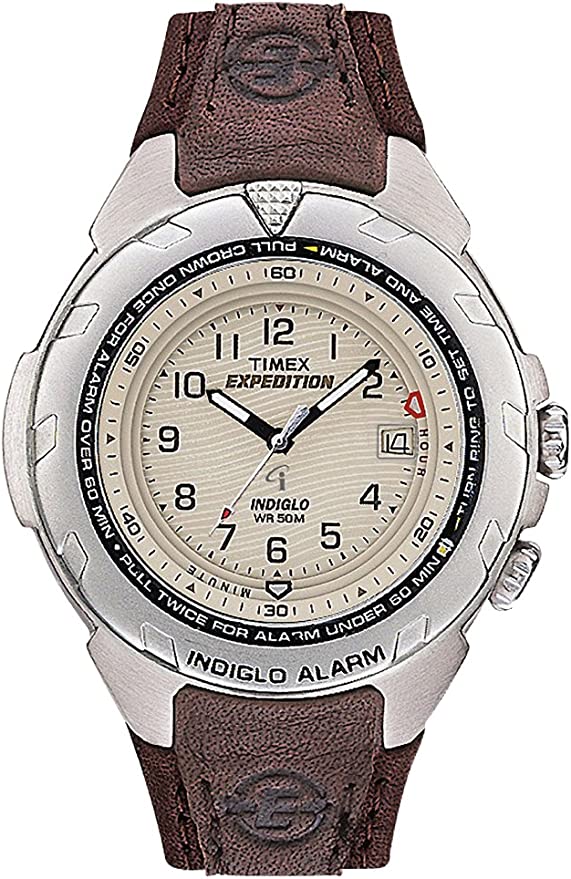
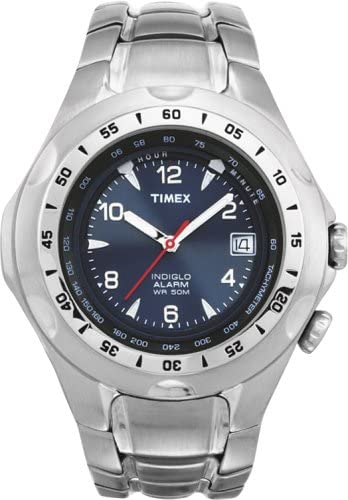
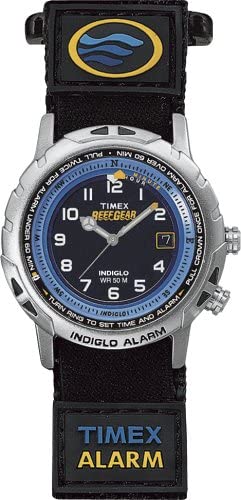
The Timex Turn-N-Pull Easy-Set Alarm was a complication available in several product lines: the Reef Gear, the Expedition, and as its own line. Sold throughout the aughts, I suspect that the emergence of smartphones killed it.
Goin' the way of the dinosaurs
I started digging into alternatives. To replicate the UI, contenders had to be analog models. There were none that had that tactile feeling of turning the bezel. Nor were there any that offered the precision of the Turn-N-Pulls, which enabled its user to set the alarm accurately to the minute by separating both hour and minute markers. The closest thing for analog watches was to buy an alarm watch. Alarm watches are no longer common; Seiko Bellmatics sold for at least four hundred dollars and the Poljots and Burans (Russian alarm watches) were a hundred fifty dollars brand new.

This is when I truly experienced, for a bit, what it was like to be "in the hobby". This feeling of chasing after something, becoming invested in the model's history, its movement, understanding the bit of backstory as to why only Russia produced these kinds of watches any more — it made me feel like I was participating in something that's been going on for longer than I'd been around. This feeling may not have been as strong for me as the punch to my nostalgia gut with the CasiOak, but the gravitational pull was there. The gravitational pull was serendipity, the hope that the stars would align and you'd find your fish.
So that's what the hobby is about, at least for as far as I've gone. There's the personal history, the institutional or cultural memory, and the serendipity of the occasion, colliding in this tiny package that wraps up our identities, that speaks for us without us having to declare anything.
Along with that chase came the feeling that I'd buy "anything" if it met the illusory need. The Timex Turn-N-Pulls were reasonable watches, around 70 USD when they first hit the market; by the time I was looking at Poljots I'd been on the trail for hours and I thought the 150 USD price point was reasonable next to Seiko Bellmatic (and much more reasonable next to the Vulcain Cricket). How'd I go from fifty dollars to triple that amount on a watch that was, feature-wise, a compromise?
At the end of the day I dug no deeper down the rabbit hole. There was no need for me to bid on a Seiko Bellmatic nor would I support anything Russian-made given Russia's warmongering. I was still riding a wave of serendipity, the discovery that I could even like a watch, that I'd wear a watch to begin with, that a watch could remind me of something.
Other leads for another time
I let the Turn-N-Pull concept go. WatchUSeek was ready to get me fired for another research trip, the happy end of which I'll make a separate post about. For now I'm content to wrap this post up.
It was fun to discover I liked this kind of bling. Yes, I wear gold, but I'd never seen a bit of fashion, that is worn as jewelry nowadays, be so cheerfully plastic and tough and useful. It's nice to walk away from phones; oftentimes we've heard about watches as the taskmasters of the tyrant that is time, but truthfully it is phones these days that fill that role in our lives. I look at the phone less now, when I'm around the house, or traveling, or meeting a friend.
The fortuity, I think, is what will convince me to go watch window-shopping every now and then. We like to make connections, to make sense of the events in our lives, so when someone passes a watch down the family line — that is serendipity — when our partners happen to drag us into a store on an assignment — that is serendipity — when we happen to discover nice analog and digital UIs and trace the history of technology — that is serendipity.
Finally, there's network effects. So much of my chase went on because of Reddit and WatchUSeek. I would have run out of steam early without the Internet. I wouldn't have been so familiar with high end, low end, niche, and mainstream watch brands were it not for the Internet. It is so easy to learn, to gain an appreciation for something like a watch and why people would find it meaningful to grow and cultivate a collection, just as it is easy to fall, fall, fall and live beyond your means. The pendulum of desire swings between consumerism and connection, or perhaps it is a tightrope, one I don't regret walking to the end — at least this time around.


